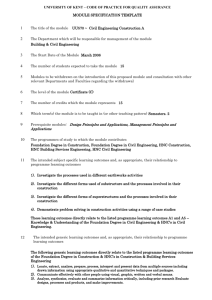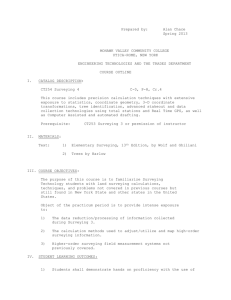University of Kent at Canterbury
advertisement
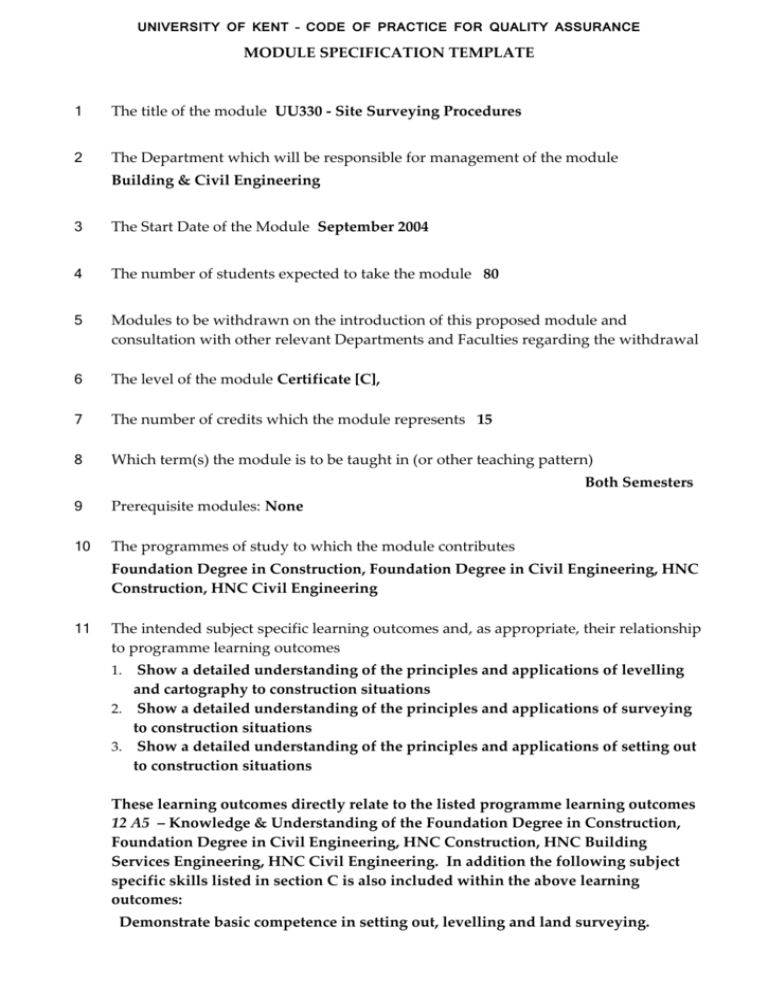
UNIVERSITY OF KENT – CODE OF PRACTICE FOR QUALITY ASSURANCE MODULE SPECIFICATION TEMPLATE 1 The title of the module UU330 - Site Surveying Procedures 2 The Department which will be responsible for management of the module Building & Civil Engineering 3 The Start Date of the Module September 2004 4 The number of students expected to take the module 80 5 Modules to be withdrawn on the introduction of this proposed module and consultation with other relevant Departments and Faculties regarding the withdrawal 6 The level of the module Certificate [C], 7 The number of credits which the module represents 15 8 Which term(s) the module is to be taught in (or other teaching pattern) Both Semesters 9 Prerequisite modules: None 10 The programmes of study to which the module contributes Foundation Degree in Construction, Foundation Degree in Civil Engineering, HNC Construction, HNC Civil Engineering 11 The intended subject specific learning outcomes and, as appropriate, their relationship to programme learning outcomes Show a detailed understanding of the principles and applications of levelling and cartography to construction situations 2. Show a detailed understanding of the principles and applications of surveying to construction situations 3. Show a detailed understanding of the principles and applications of setting out to construction situations 1. These learning outcomes directly relate to the listed programme learning outcomes 12 A5 – Knowledge & Understanding of the Foundation Degree in Construction, Foundation Degree in Civil Engineering, HNC Construction, HNC Building Services Engineering, HNC Civil Engineering. In addition the following subject specific skills listed in section C is also included within the above learning outcomes: Demonstrate basic competence in setting out, levelling and land surveying. UNIVERSITY OF KENT – CODE OF PRACTICE FOR QUALITY ASSURANCE 12. The intended generic learning outcomes and, as appropriate, their relationship to programme learning outcomes 1. Apply knowledge and understanding to address familiar and unfamiliar problems, including collecting, analysing and interpreting data, using appropriate quantitative and other equipment, and using standard and relevant IT software 2. Work effectively with others within the context of a team within an interdisciplinary environment These learning outcomes directly relate to the listed programme learning outcomes: D Transferable Skills of the Foundation Degree in Construction, Foundation Degree in Civil Engineering, HNC Construction, HNC Building Services Engineering, HNC Civil Engineering 13. A synopsis of the curriculum Levelling: traditional & laser levelling techniques to establish control and measure heights. Booking and use of software. Cartography: Contouring by direct & indirect methods. Cross sections. Coordinates and bearings. Surveying: digital & optical theodolites to establish control, total station and EDM, GPS. Traverse with angular & linear corrections, software applications Setting Out: Working from the whole to the part, Buildings, drainage and curves on roads. Vertically of structures. 14. Indicative Reading List Irvine, W (1995) Brighty, S (1989) Schofield, W (2001) Surveying for Construction Setting Out Engineering Surveying McGraw-Hill BSP Professional Butterworth 15. Learning and Teaching Methods, including the nature and number of contact hours and the total study hours which will be expected of students, and how these relate to achievement of the intended learning outcomes A variety of learning and teaching methods will be employed. Students will be expected to spend a total of 150 hours of study which will be apportioned as follows: 47 contact hours involving a mixture of lecture and classes. Much of the content will be directly taught through a variety of class-based activities. Lectures will be used to provide general underpinning knowledge and explain the various principles. However, emphasis is upon student-centred activities including research tasks, group work, individual tasks, presentations and demonstrations which will be organised to develop the transferable skills outlined in section D of the programme specification. IT applications will be included with workshops provided where required. Tutorials will be arranged to assist and direct the students in their work; to give feedback on coursework; to diagnose learning difficulties; and provide guidance and counselling. 40 hours – assessment & revision 63 hours – private study UNIVERSITY OF KENT – CODE OF PRACTICE FOR QUALITY ASSURANCE 16. Assessment methods and how these relate to testing achievement of the intended learning outcomes A full range of assessment methods will provide students with a varied menu of assessment experiences. Formative methods will be used to provide maximum feedback and support to facilitate continual progress. Coursework (70%) will comprise a number of assignments to assess the competence of the skills inherent in the specific and generic learning outcomes. Verification exercises (30%) will authenticate the work carried out in the coursework assignments. Subject specific learning outcomes 1. Show a detailed understanding of the principles and applications of levelling and cartography to construction situations Assessment Criteria 2. Show a detailed understanding of the principles and applications of surveying to construction situations 3. Show a detailed understanding of the principles and applications of setting out to construction situations Demonstrate knowledge of levelling techniques including booking field measurements and checking for errors Demonstrate knowledge of direct contouring techniques Demonstrate knowledge of indirect contouring techniques. Calculate contours using different methods Demonstrate knowledge of different bearing techniques with applications to co-ordinate representation Demonstrate knowledge of the correct use of optical theodolites for the measurement of angles of azimuth connected with traversing Demonstrate accurate plotting skills associated with compass, or theodolite traverses including appropriate error connections Demonstrate basic competence in setting out techniques associated with road cones or building column positions Establish vertical and horizontal control profiles appropriate to construction applications Demonstrate competence with laser levelling techniques UNIVERSITY OF KENT – CODE OF PRACTICE FOR QUALITY ASSURANCE Generic Learning Outcomes 1. Apply knowledge and understanding to address familiar and unfamiliar problems, including collecting, analysing and interpreting data, using appropriate quantitative and other equipment, and using standard and relevant IT software Assessment Criteria Show evidence of addressing problems associated with new skills and technology Use IT applications, where appropriate to assist surveying tasks. 2. Work effectively with others within the context of a team within an interdisciplinary environment 17 Undertake fieldwork competently as part of a team Contribute positively to the completion of group tasks and targets to meet deadlines Implications for learning resources, including staff, library, IT and space. This module will be taught by appropriately qualified lecturers who have experience in delivering these topics. All the items stated in the Indicative Reading List are available at the Horsted Centre, Learning Resource Centre IT suites which all allow Internet, On-line T.I. Onestop Technical Index Facility are also available for students to book as required. In addition the Department boasts its own IT/AutoCAD suite which is incorporated in the programme operation. The teaching accommodation includes a surveying school suitably equipped and adapted for teaching site surveying procedures classes (see programme specifications section 14.8). 18 A statement confirming that, as far as can be reasonably anticipated, the curriculum, learning and teaching methods and forms of assessment do not present any nonjustifiable disadvantage to students with disabilities The learning outcomes, teaching and learning methods and assessments are accessible to and achievable by all students. Any student with disabilities will not face any foreseen disadvantage or difficulties that cannot be reasonably addressed. Statement by the Director of Learning and Teaching: "I confirm I have been consulted on the above module proposal and have given advice on the correct procedures and required content of module proposals" ................................................................ Director of Learning and Teaching .............................................. Date Statement by the Head of Department: "I confirm that the Department has approved the introduction of the module and will be responsible for its resourcing" ................................................................. Head of Department Revised August 2002; Revision 2 in 2003. .............................................. Date
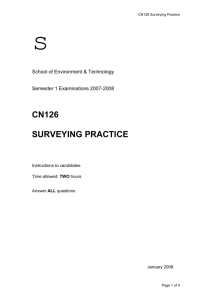

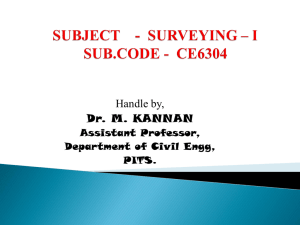

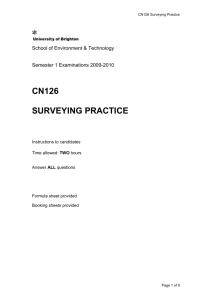



![the registration form [DOC format, 30KB].](http://s3.studylib.net/store/data/007326701_2-7aa061ae2787fe2d09dcfa408150476a-300x300.png)
